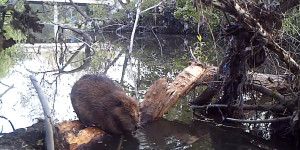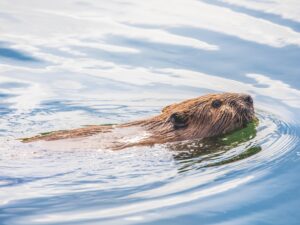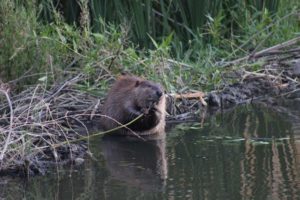In the heart of San Jose, nestled between the glass and steel of HP Pavillion and a busy highway, some long-unseen locals have moved back to town.
Beavers have returned to a spot at the confluence of Los Gatos Creek and the Guadalupe River for the first time in 150 years, setting off a scurry of excitement among conservationists.
“I was elated to hear about the beavers,” said Leslee Hamilton, executive director of the Guadalupe River Park Conservancy in San Jose. “The Guadalupe River seemed like a prime candidate [for beavers] so I wasn’t surprised when they appeared, merely ecstatic.”
Roger Castillo, a San Jose salmon advocate, discovered the beavers in early March when he saw freshly chewed trees along the riverbank. It didn’t take long before wildlife photographer Greg Kerekes got involved and started filming the newly arrived beaver family — a pregnant female and two yearlings — using infrared cameras at night. So far, he has captured them eating fennel and willow branches along the river and grooming one another.

From the St. John Bridge that crosses the river yards away from the beavers’ home, San Jose’s high rise buildings peek out above the trees. On the banks of the river, feral cats prowl the shrubs in search of a meal, and discarded plastic bottles and other trash back up in the waterway.
Not a portrait of a pristine habitat, but for the San Jose beavers this is now home.
“Our environment is not in the same condition it was when the beavers left in the late 1800s,” said Kerekes. “Their habitat is a fraction of what it was and now they must put up with rusty pieces of metal, chemical pollution, and human disturbance.”
How the beaver family got there is a matter of speculation. Heidi Perryman, president of Martinez beaver advocacy organization Worth a Dam, suspects they were part of a colony from upper Los Gatos Creek, near Lexington Reservoir, and swam downstream to the Guadalupe River confluence.
Beavers are the largest rodent in North America. Once hunted to the brink of extinction for their highly sought-after fur, they have since made a strong comeback in some areas, thanks to restrictions on hunting and trapping. In California it is illegal to hunt beaver in 16 counties, among them the Bay Area counties of Santa Clara, San Mateo, Sonoma, Marin, San Francisco, and Santa Cruz.
Well known for its semi-aquatic lifestyle, Castor canadensis aided by webbed hind feet and a layer of insulating blubber. They are also one of the few species, aside from humans, who can so dramatically alter their surroundings to create a new habitat.
In shallow water, beavers will construct dams of logs, mud, and even rocks to create deep ponds that provide access to food and protection from predators. Beavers however, do not live in the dam but rather build a separate “lodge” from similar materials or, like the San Jose beavers, live in a burrow in the bank.
Because of beavers’ habitat-altering ways, people often worry that their dams will pose a flooding threat. However, the San Jose beavers have not yet constructed a dam and it’s unlikely they will.
“The situation is conducive for them not to build a dam,” said Doug Titus, a biologist with the Santa Clara Valley Water District. “The pool that they’re living in is deep and the current water levels are maintained for the entire year.”
Moreover, the beavers are located just yards away from a large bypass channel and any overflow will be redirected, Titus said.
When beavers arrived in Martinez seven years ago, an influx of other species came in on their coattails. Sacramento spittail, a member of the carp family seen most often in the Central Valley, and American mink made an appearance along Alhambra Creek. Perryman attributes this to the beaver’s role as a “keystone species”—a species that has a disproportionately large effect on its environment.
“Beavers do these really specific behaviours that create the conditions for the next species that will follow,” explained Perryman.
For example, trees chewed by beavers grow back in a natural coppice, denser and bushier. This regrowth then becomes nesting habitat for migratory and resident birds.
In some situations, beaver dams can benefit native fish species including chinook salmon and steelhead trout by creating ideal conditions for juvenile fish (smolt) to mature in deep water ponds.
Recovering urban habitats like this one are rarely so simple, however. Officials with the water district are concerned that, at the Guadalupe River site, such pools could hinder fish migration or create warm water conditions conducive to invasive predators such as Asian carp.
“We would look at it on a site specific basis with consideration for the threatened steelhead, and get a professional opinion from a fishery biologist to see whether the benefits would outweigh the impact,” said Titus of the water district.
But just as the arrival of Sutro Sam—San Francisco’s famous river otter—seemed to signal the health of many of the small creeks that drain into the ocean, advocates hope the beaver’s return marks the revival of the Guadalupe River.
“The beavers’ return is really testament to nature’s resilience,” said Greg Kerekes. “These species are working their way back into the ecosystem but only if given the right conditions.”





